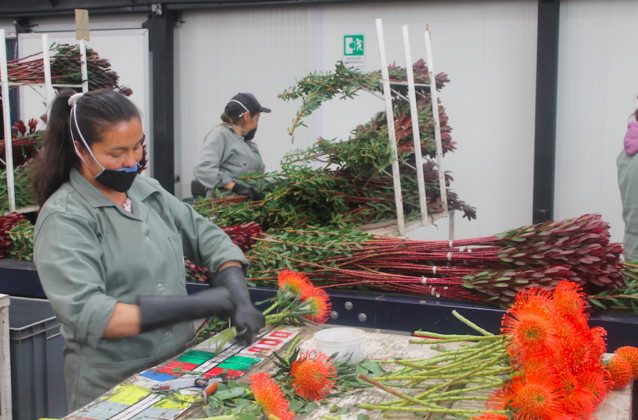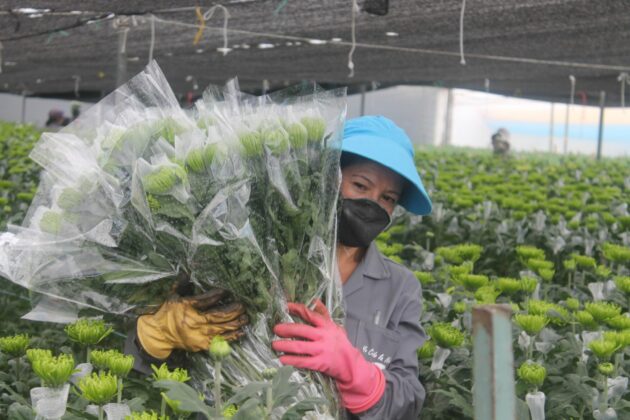The Colombian floricultural industry is doing well. The past three years, growers have been making money again. It seems like there aren’t too many things that could get in the way of a sunny outlook. Floribusiness visited the Proflora trade show in Bogotá and a few Colombian farms. “We’re trying to sell our flowers worldwide, to avoid total dependence on a single market.”
Arie-Frans Middelburg
“The Colombian government devalued the peso in 2014, and since then the floricultural industry has been doing very well”, explains Fernando Fonseca. Fonseca is the President of Proflora, the Colombian floricultural trade show that took place in Bogotá last week. The fair is organised by Asocolflores, the association of Colombian flower exporters. The exhibitors, mostly Colombian flower growers, were in a good mood because for the past three years, they’ve been making money again. Even Maria, Irma and the strike at Avianca airways failed to put a damper on the positive atmosphere.
It hasn’t always been like that, though. The unfavourable exchange rate of the peso against the American dollar meant that the Colombian economy wasn’t great for quite a few years. They only got a few pesos for the dollars (standard market currency) they earned, which meant that their income was low, while their costs were high.
On top of that came the financial crisis in the United States in 2008. Colombian flower farms that were selling mostly to the USA, had a tough time.
Fonseca, owner of carnation nursery Discovery Farms, which has been around for 45 years, witnessed how many farms had to close down. The Colombian downfall didn’t have as big an impact on Discovery Farms, because its most important market is Europe. “And as the supply of carnations decreased, we could increase our prices”, said Fonseca.
Free trade agreements
Fonseca explained that Colombian nurseries managed to reduce their production costs by working more efficiently. In addition, farms started to explore new distribution markets, so they would no longer be so dependent on America.
Sales manager Catalina Guacaneme of Plazoleta, grower of alstroemeria, snapdragon, statice, limonium, leucadendron and solidago, indicated during our visit to her company that America is still their most important distribution market. But they did expand their sales channels the last couple of years and are now also selling to for example Russia, China (more and more), Japan, South Korea, Europe and England. “We’re trying to sell our flowers worldwide, to avoid total dependence on a single market.”
Ricardo Otero said something similar during our visit to his chrysanthemum nursery Yasa: “We used to export just to the USA. Nowadays, we’re exporting to Europe, Japan and Australia. We’ve only got three or four customers left in the USA.”
For the past three years, things have really improved for the Colombian floricultural industry. Nurseries are making money again and the growth is back, especially with the very large companies. Colombian export also benefits greatly from the free trade agreements they have with the United States and Europe. South Korea will be added later on this year. During the opening of Proflora, a week ago last Wednesday, Maria Lorena Gutierrez explained that more than 90% of the Colombian growers’ exports are subject to ‘preferential access’.
There’s a lot of goodwill with regards to trading with Colombia, as the country is trying its best to end the civil war that’s been going on there for the past fifty years. Peace with the FARC is already a fact and the current truce with ELN, another guerrilla group, should result in a peace treaty.
Marjolijn Sonnema, Director General Agriculture and Nature at the Dutch Ministry for Economic Affairs, referred to the ongoing peace process as a positive development for Colombia and the rest of the world. It encourages other countries, including the Netherlands, to expand their collaborations with Colombia. This is also illustrated by the Dutch appointment of Patricia de Vries as an Agricultural Attaché. Her job is to support the developments in the Colombian agricultural sector and to strengthen the relationship between the two countries. Sonnema indicated that KLM is considering to increase the number of cargo flights to Colombia from three to four.
Threats?
Colombia’s competitive position compared to other countries such as Ecuador, which has a dollar economy and very high labour costs, seems very strong at the moment. Aren’t there any threats at all for Colombia? Yes, there are. In the first week of September, hurricane Irma caused a lot of trouble in Miami, the most important American hub for flowers from South America. The after-effects are still felt. Furthermore, Avianca airways is still on strike.
These kind of things drive up the prices. For now, the threats seem to be short-term problems. However, some Colombians did express some more serious concerns regarding the availability of cargo flights; they feared that the shortage might become a structural problem because aircrafts always return empty as there isn’t enough cargo going to South America. Which means that freight costs might increase.
Another topic that frequently came up in Colombia was labour. More and more industry is being moved to the outskirts of the city and farms are competing with these factories when it comes to labour. This has made labour more expensive. According to Fonseca, finding workers isn’t the problem, but keeping them is more of a challenge. “Employees don’t really stay on, they tend to switch to other sectors, like the building industry, overnight. Young people aren’t consistent. They take advantage of whatever work is available at a nursery and when it’s done, they leave. Offering them training is a waste of time.”
Tax increase
Colombia is currently led by President Juan Manuel Santos. He was Vice-President under his predecessor. Santos has chosen his own path, though. Where Uribe used to fight with the guerrilla groups, Santos is making peace. Jose Azout of Alexandra Farms, grower of garden roses for cut flowers, points out that taxes have gone up (income tax is at 42% now) since Santos came into power. Whether Santos is going to move further towards the political left is uncertain.
Another possible threat for Colombia are flowers from Kenya; since a couple of months, they can be flown directly from Nairobi to the USA. Fonseca agrees that these Kenyan flowers compete with the shorter varieties of Colombian roses. But a lot depends on the freight costs from Nairobi to the USA.
Azout has a different opinion. He’s been hearing people talk about Kenyan flower exports to the USA for ten years now. “I used to fear those developments for a long time, but the direct flights to Miami are too expensive and if they go through New York, they won’t have the required infrastructure for further distribution of the flowers.”
All in all, the biggest Achilles heel of the Colombian floricultural industry seems to be their dependence on the currency exchange rate of the peso against the dollar. Colombian flowers are paid for in dollars almost everywhere. And there’s still the large dependence on the American market, too. Something that rose growers are feeling at the moment, according to Fonseca. Since the pressure on the Russian market increased, Ecuadorian rose growers have been shifting their focus to the USA and that has had an impact on the Colombian rose growers, he said. However, he didn’t need too many words to describe how he sees the future: “Colombia will always be active in the floricultural industry.”
Colombia in numbers
Colombia is the second largest flower export country. The Netherlands is number one.
According to the figures from Asocolflores, their flower exports reached a total value of $1.3 billion last year. This concerned 225,000 tons of flowers, shipped to 90 different countries. 78% went to the USA, 4% to the UK, 4% to Japan, 3% to Canada, 2% to Holland, 2% to Russia and 9% to other countries. The exports to the Netherlands consisted mainly of carnation ($16 million), rose ($6 million), alstroemeria ($2 million) and other ($2 million).
The total acreage of flowers in Colombia is 7,335 ha. Rose has the largest share in the flower export value: 23% ($305 million). Carnation is number 2 with 16% ($212 million). Chrysanthemum comes 3rd with 11% ($147 million).
The main production area is Cundinamarca, with 5,056 ha. Antioquia has 2,247 ha. Asocolflores is the Colombian association of flower exporters. They represent more than 250 farms, which jointly supply more than 65% of the flower exports. There are five very large farms in Colombia, which are responsible for around 80% of the total production.
The Colombian floricultural industry has been around for fifty years and is continuing to grow. Trade Minister Maria Lorena Gutiérrez said at Proflora that production increased by 12% between 2012 and 2016. This year, Colombian flower exports have gone up by 7% so far.
The Colombian floricultural industry provides 130,000 direct and indirect jobs. A total of 600,000 Colombians’ livelihood depends on the floricultural industry. According to Asocolflores’s figures, 65% of the nursery workers are female and many of those are single mums.
















